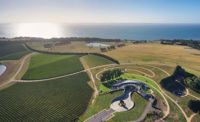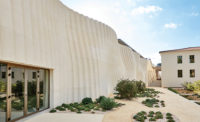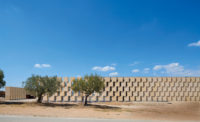In the late 1800s, George W. Vanderbilt commissioned architect Richard Morris Hunt to design a chateau—the largest residence in the United States—and a dairy barn on his estate. The resulting dairy barn was a three-winged building, joined by a central spine, that featured a four-sided clock tower in the center. In the 1980s, the dairy barn was converted and enlarged to become the Biltmore Winery. However, this original renovation clouded some of the dairy barn's original features. As a result, the architects of this project sought to reintroduce clarity to the original design and return the building to some of the basic principles established by Hunt.
To enlarge the amount of sales space, the architects established a defined circulation flow and customer orientation through the construction of the new entry portico, brick pavilion, and tour patio. These features seek to create a sense of monumentality and spatial differentiation through visual hierarchy. The architects added smaller venues, such as a premium tasting counter, a cooking demonstration area, and a general merchandising space around the pavilion.
Existing architecture was used as a design precedent for the renovations. For example, the original arches of the clock tower inspired the wood arches located throughout the project. The wood columns, brick foundation, wrought iron details, and heavy timber also continued the original dairy barn's aesthetics. To create a strong visual harmony between old and new construction, the architects used some of the old materials, such as stones from the estate's courtyard to create the new patio floors. The redesigned ceilings, various flooring materials, and strategic lighting all reflect the influence of the original design.







Post a comment to this article
Report Abusive Comment